Shortly after Franklin Roosevelt ordered the internment of Japanese Americans in 1942, the War Location Authority hired photographer Dorothea Lange to document the process. I strongly suspect that whoever made the decision knew little about her previous work, but learned that she had worked for the federal government and that she lived in California, where most of the internees lived. She is now recognized as one of the greatest American documentary photographers, even a major influence on the very definition of documentary photography, but in 1942 very few knew her name.
Lange spent her first fifteen years as a photographer, approximately 1920 to 1935, doing studio portraiture in San Francisco. At this she was extremely successful, and became the preferred photographer of the city’s artistic and wealthy elite, including the Levi-Strauss family and artists such as composer Ernest Bloch; she was then married to prominent artist Maynard Dixon, and she socialized with artists, bohemians, and her wealthy clients. When Diego Rivera made his first visit to the US in 1930, he fell in with that crowd and Lange loaned her studio to Frida Kahlo.
In 1935, restless and bored with her studio photography, she took a job with the Farm Security Administration (FSA) of the Department of Agriculture. Her assignment was to document the impact of the depression on farmers and farmworkers; these photographs were widely published as a means of building support for President Franklin Roosevelt’s agricultural policies. These photographs, however, then appeared without the name of their creator. Since then, however, she has become most famous for this work: her photographs of migrant farmworkers and sharecroppers have been so widely published that those who do not know her name almost always recognize her pictures. She has been the subject of many major museum exhibits. Several dozen art books feature her photographs and they also appear as illustrations in hundreds of books, magazines, even advertisements. (Since the bulk of her work was done for the federal or California state government, it is in the public domain and anyone can use it gratis for any legal purpose whatsoever.)
Until 2006, almost no one knew of her photographs of the Japanese internment. These were also commissioned by the federal government, but had never been published as a collection, and approximately 97 percent of them have never been published at all.1 Their neglect resulted from US Army censorship: once the brass saw the photographs, they quickly impounded them for the duration of the war, and afterward placed them in the National Archives.2 US Army Major Beasley actually wrote "Impounded" across some of the prints (luckily, not on the negatives). In the course of writing Lange’s biography, I found these photographs and published, with co-author Gary Okihiro, a selection of them in Impounded: Dorothea Lange and the Censored Photographs of the Japanese American Internment (W. W. Norton, 2006).3
The photographs were impounded because they were unmistakably critical. They unequivocally denounced, visually, an unjustified, unnecessary, and racist policy. (That perspective is readily visible if you compare them to the photographs of Ansel Adams, published in 1944 as Born Free and Equal, of which more below.) Lange’s photographic critique is especially impressive given the political mood of the time--early 1942, just after Japan bombed Pearl Harbor. Hysterical fears of further Japanese attacks on the west coast of the US combined with a century of racism against Asians, including Chinese, Filipinos, Indians as well as Japanese, to create a situation in which, as Carey McWilliams, later to become the editor of The Nation, remarked, you could count on your fingers the number of "whites" who spoke publicly against sending Japanese-Americans to concentration camps.4 Even liberal Dr. Seuss (Theodore Geisel) contributed a racist anti-Japanese cartoon.5
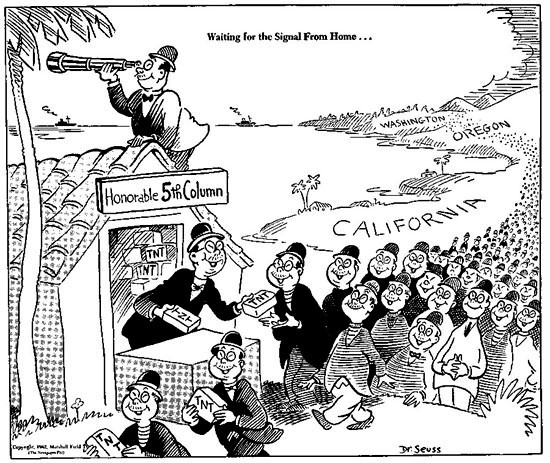
In her years as a studio photographer, with an elite clientele, nothing suggested that politics or political radicalism interested her. She was an ardent New Dealer and deeply admired FDR, but never a protester. Still, her life in San Francisco was slightly more multicultural than was typical among whites. Immersed in the city’s bohemian art world, she had eaten in Chinatown restaurants, where most white San Franciscans feared to go, and drunk wine in Italian cafes at a time when most native-born white Americans drank only beer and whiskey. But in her studio work Lange had almost never photographed nonwhites until she married Paul Schuster Taylor, a progressive professor of economics at UC Berkeley. His major research subject was agricultural labor, and he was the rare economist who actually talked with and listened to his subjects as well as collecting data about them. He was the only Anglo scholar to study Mexican Americans in the 1920s, and was one of the few Anglos to question the internment from its beginning.
Operating like an ethnographer, Taylor collected the immigration and work histories of his subjects and became a staunch ally of farmworker organizing struggles. Coincidentally, he had been carrying a camera and making pictures to illustrate his research since 1919, and in 1927 when he undertook a massive survey of Mexican labor in the US, he made photographs part of his data,6 so when he saw some of Lange’s work he appreciated its quality. It was Taylor, well connected to progressives in the Department of Agriculture, who got her the FSA job; working with her in the field, he educated her about the exploitive and even brutal treatment of migrant farmworkers, especially African Americans and other "nonwhites" of Mexican and Filipino backgrounds. She learned from Taylor and from the evidence before her eyes how diverse racisms intensified and naturalized the exploitation of labor, and permeated regional cultures. Taylor and Lange divorced their spouses and married each other in 1935, creating a personal, professional and political partnership that lasted to the end of her life in 1965.
Lange’s most famous photo, sometimes called Migrant Mother, became the most widely recognized photograph in the US, but it created a false impression of her focus. Still today many think of Lange as a photographer of the “Okies,” white victims of drought and dust storms who migrated west to work in the agricultural fields. In fact, this group comprised a very small part of Lange’s subjects. The greater part of her work focused on southern sharecroppers, both black and white, and farmworkers employed by the vast corporate farms of the west coast. There is a reason for this misimpression: the FSA distributed almost exclusively photographs of whites, on the premise that only white victims of the Depression could evoke public sympathy.
Looking back now at Lange’s FSA work, we can see her representing these various farmworkers as citizens and as unique individuals. The common denominator among these photographs was respect. Her images of sharecroppers and migrant farmworkers had no less gravitas than her portraits of San Francisco’s symphony conductors and corporate executives.
This vision is directly relevant to this story: Lange’s critical take on the Japanese internment flowed directly from her experience of racism in California’s agricultural employment.
Shortly after Lange’s job with the FSA ended, Imperial Japan bombed Pearl Harbor. Major California media and political leaders presented the Japanese enemy in racial rather than ideological terms. Very little of this commentary remarked on the politics of Imperial Japan, and almost all argued or assumed that the danger was in Japanese “blood.” Rumors, almost all false, of spies, sabotage, and potential attacks circulated widely. A few authenticated attacks -- for example, in February 1942 submarines shelled a Santa Barbara oil refinery; in June a submarine shelled the Oregon coast; in September a plane dropped 2 incendiary bombs near Brookings, Oregon -- escalated the fear-driven hysteria, although no one was hurt and damage was minimal. Moreover, the executive order calling for evacuation came out before any of these attacks occurred. Military leaders ratcheted up the anti-Japanese fever. General DeWitt, head of the US Army’s Western Defense Command opined that "The Japanese race is an enemy race and while many second and third generation Japanese born on American soil, possessed of American citizenship, have become `Americanized,’ the racial strains are undiluted .... The very fact that no sabotage has taken place to date is a disturbing and confirming indication that such action will be taken ..."7 That kind of hysterical illogic went largely unchallenged.
In February 1942 FDR ordered the internment of Japanese and Japanese Americans on the West coast,8 regardless of their citizenship, and the War Relocation Authority (WRA) was established on March 18 to organize their removal. The WRA then hired Lange to document the program photographically. The WRA was then headed by Milton Eisenhower, brother of Dwight, who had previously worked for the Department of Agriculture; he might well have been acquainted with Paul Taylor and Lange’s reputation as the FSA’s most in-demand photographer had probably reached him. Therein lies an irony. No doubt she had received an enthusiastic recommendation because her work had so perfectly promoted the Department of Agriculture’s 1930s agenda; the WRA probably expected the same now but did not get it.
Lange was eager for the job, and Taylor was eager for her to do it. He was already a member of a University of California/Berkeley faculty committee questioning the necessity for the internment. He may have wanted information available only to someone admitted to the internment camps. Did she know in advance that she would be a subversive employee, I wonder? Apparently no one ever asked her that question, and there is no written evidence. When I interviewed her assistant in this work, Christina Gardner, I suggested that perhaps the government had not expected her pictures to be so critical—to show the losses of people forced to leave jobs, schools, and property, or to show the miserable conditions in the camps. Gardner responded, "what else was there to show?"9
Still, Lange’s willingness to show the humiliation and suffering of the internment is remarkable for another reason. She adored FDR, not least because she too lived with a disability created by childhood polio. But it was this President who had ordered the internment. So her visual denunciation represented not only courage but also what must have been a painful integrity in flouting a Roosevelt policy.
Lange began by photographing the rounding up of Japanese Americans in California, not an easy task because many of them were rural, operating often as truck farmers. So Lange drove throughout the Bay area and California’s vast Central Valley. Then she went to the temporary "assembly centers," where internees were housed until the long-term camps were ready. Finally, and in late June-early July of 1942, she worked at the Manzanar camp. Then she was fired and her photographs impounded for the duration of the War. She was required to turn over all negatives, prints and undeveloped film from this work. "I had to sign when I was finished, under oath, before a notary."10 Afterward the films were quietly placed in the National Archives in Washington, rather than with the bulk of her government photography in the Library of Congress. As a result few knew they were there—Lange herself did not know this for many years.
In her previous documentary work, Lange’s photographic technique required putting her subjects at ease. She introduced herself as working for President Roosevelt; she talked with her subjects, asked questions. She never tried to get "candid" pictures of unaware subjects as FSA photographers Ben Shahn and Walker Evans did, and she never photographed indoors because she did not like how flash bulbs made her subjects look. I suspect that she exaggerated her limp in order to appear unthreatening, and worked deliberately slowly; like all good portrait photographers, she knew that most people tense up in front of a camera, so she wanted them to loosen up, even to forget the camera and become involved in conversation. A good portrait, she remarked, required that her subjects relax into their “natural body language.” She never used 35-mm cameras, which are held in front of your eyes, but large, heavier cameras, held at waist level; by looking down at a waist-high camera to see her image, she could spend most of the time looking at and talking with her subjects. She used the heavier cameras she had been accustomed to: a Zeiss Juwell, a ground glass camera, urged upon her by Ansel Adams, and a Graflex, her old favorite for studio work but too heavy to carry around for any length of time.
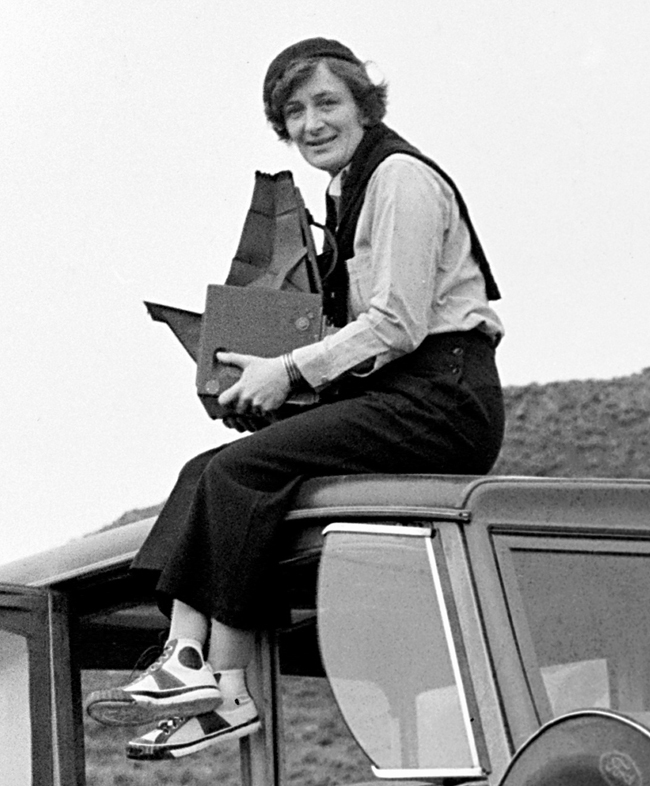
These were view cameras, with negative sizes of 4" x 5" or so. The assistant would see that each camera was always loaded with film so that Lange could switch cameras quickly.
She had to modify this approach radically, however, in this job because she had to negotiate conflicting constraints. First, in the 1930s she had been working for a government committed to relieving suffering; now she was documenting a suffering created by the government in an operation she came to consider odious. Second, she could not be completely open with her supervisors. Third, the WRA imposed restrictions on what she could photograph: no talking with internees, no pictures of barbed wire fences or watch towers or armed guards, no photographs of the interior of the barracks in which the internees lived, nothing hinting at resistance. Thus her usual masterful documentary method wasn’t possible in this job.
On top of all that, she faced considerable harassment in trying to do the job. She was the victim of divided authority and conflicting opinions within the federal government about internment policy, and the obstacles she faced suggest that some authorities quickly tried to force her to quit. The WRA had hired her, but it was the Army that policed the round-up and the camps, and the military police (MPs) threw every possible impediment in her way as she tried to do her job. She was constantly followed. Despite weeks of visiting office to get documents authorizing her entry, she was often arbitrarily refused access to what she was supposed to photograph.11 Or MPs would repeatedly demand to see her credentials, making her lose precious time.12 Her assistant suspected that this made the internees more willing to cooperate with Lange. (Oddly, the MPs never asked her assistants for credentials, suggesting that their motive was not concern for security.) At the same time the WRA bureaucracy hassled her over mileage records, gas receipts, and made her account for every telephone call.
Lange developed a particularly adversarial relation with Major Beasley (referred to by some as Bozo Beasley13), who tried to catch her in various infractions. Once she gave a photograph to Caleb Foote, a leader in the pacifist Fellowship of Reconciliation, who used it as the cover of a pamphlet denouncing the internment. Discovering this, Beasley thought he had good cause to get rid of her. Luckily for Lange, a congressional investigating committee had also published the picture, thus putting it into the public domain.14 Another stroke of luck: Beasley thought he had caught her out in holding back a negative, but when he called her in and demanded that she produce the missing negative, she showed him that it was filed just where it ought to have been.15
Why did they hire her if they were so nervous about a photographic record? Christina Page remembered being bewildered that the MPs were so uncooperative when Lange was working for the government. But of course "government" was divided--if the Army brass in charge had been consulted, Lange would probably not have been hired. Lange’s own retrospective explanation was, they wanted a record but not a public record, that the army brass believed that a photographic record could protect against false allegations of mistreatment and violation of international law. Photography carried the risk, however, of documenting actual mistreatment.16 A measure of how important it seemed to prevent such a calamity was that the internees were forbidden to have cameras. One prize-winning professional Japanese American photographer, Toyo Miyatake, once student and assistant to Edward Weston, smuggled a lens, a ground glass and a film holder into Manzanar. There he built a camera box from scrap wood, disguised it as a lunch box, and photographed clandestinely.17 We owe much of our understanding of camp life in later years to his initiative and courage.
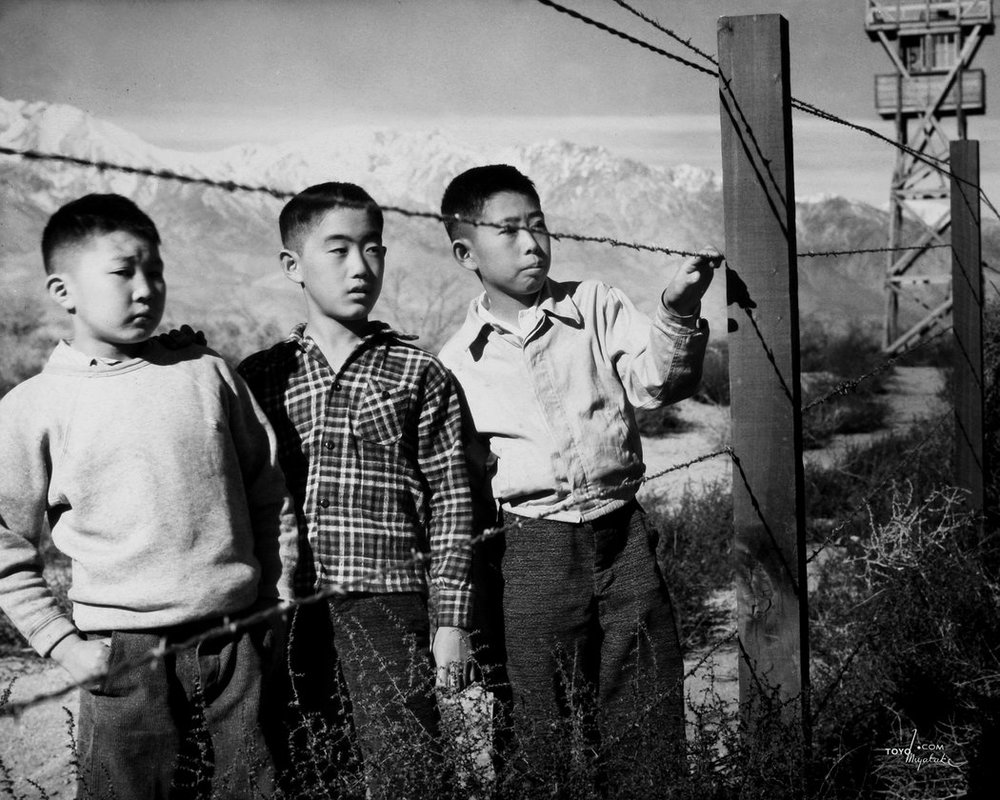
Because she was not allowed to enter the barracks, she made fewer pictures of women than of men in the camps, since men were more often outside. Once she managed a quick view inside the two rooms shared by Mr. Konda, below, his two sons and his married daughter and her husband.
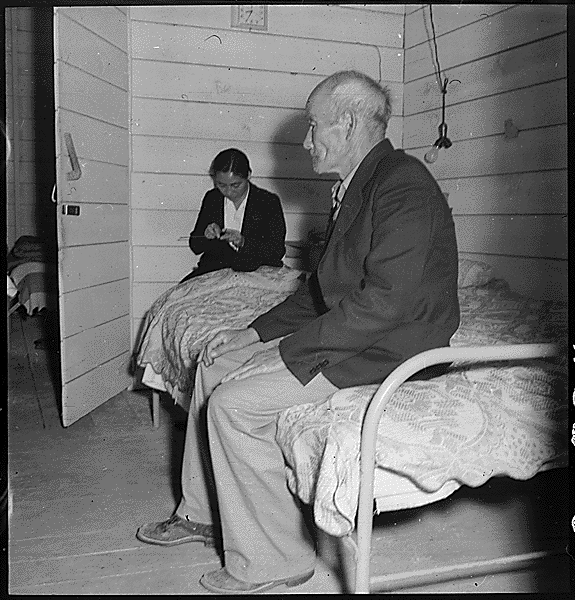
He is flatter, less complex than most of her subjects, and not just because he is not looking at the camera; Lange produced many portraits in which her subjects look away without losing their aspect of thoughtfulness or inner tension. Mr. Konda looks, simply, depressed. Of course his depression is more than adequately explained by the cell in which he lives and the prison surrounding the cell and the humiliation surrounding it all, but Lange was not typically satisfied with mere condemnation. She usually avoided expressing her convictions through creating the most painful images possible but preferred to picture the nub of human resilience that somehow survived even in oppressive contexts.
Part of Lange’s narrative strategy was to follow individuals through the internment process, which allowed her to demonstrate the terrible economic and emotional losses the internees suffered. She was able to identify particular families through Paul Taylor’s connections, which included not only farmers he had studied but also several younger Japanese Americans who were his students—until they had to drop out and report for interment. One such family was the Shibuyas of Mountain View, a town at the southern end of San Francisco Bay. She made individual portraits of each family member, showed them at work weeding, photographed their upscale house and manicured garden as well as their commercial fields, which were as meticulously tended and as clear of weeds as their lawn. She photographed daughters playing with their dog on the front lawn, the entire family posed in front of the white colonial-style house. The captions detail the achievements of the family. For example: "Mountain View, California. Ryohitsu Shibuya, successful chrysanthemum grower, who arrived in this country in 1904, with $60 and a basket of clothes, is shown above on his farm in Santa Clara County, before removal. He grew prize chrysanthemums for select eastern markets. Horticulturists and other evacuees of Japanese ancestry will be given opportunities to follow their callings at War Relocation Authority centers where they will spend the duration."18
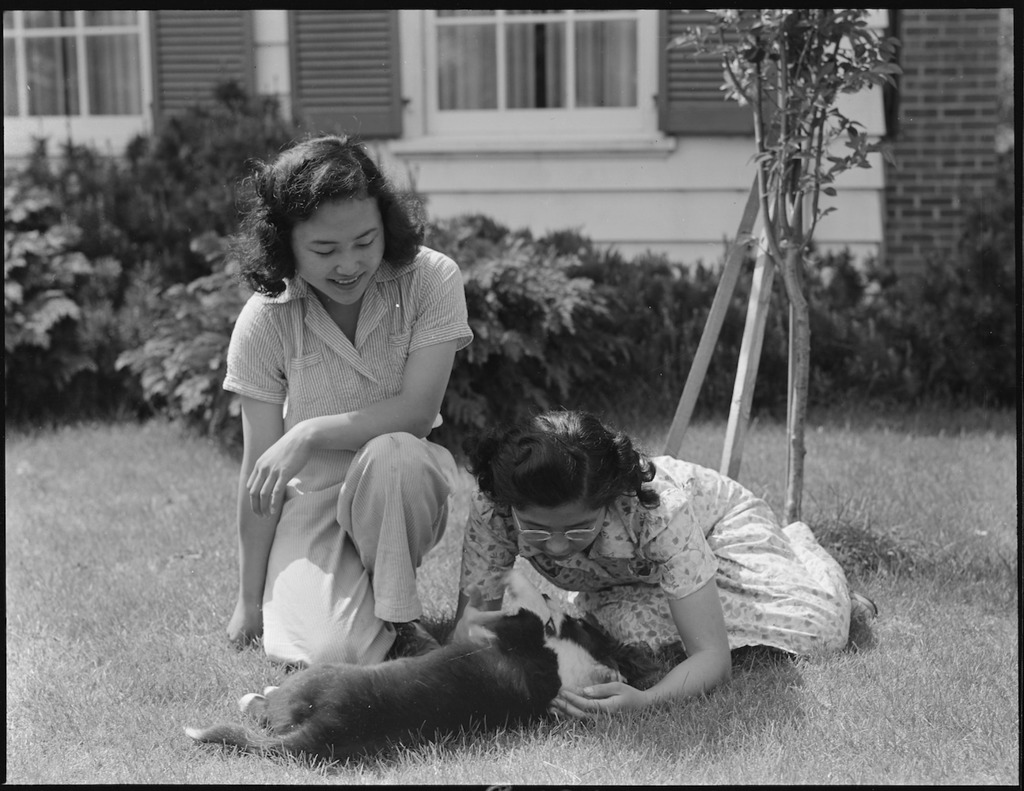
Lange devoted hundreds of photographs to displaying the respectability, Americanism, work ethic, good citizenship and achievements of these people now being treated as criminals.19 Her message was verbal as well as visual; she wrote captions for her photographs so as to underline the Americanness of her subjects. For example: "Six children in the family were born in the United States. The four older children attended leading California Universities."20 "Madoka Shibuya, then 25, was a student at Stanford Medical School when this picture was taken on April 18, 1942."21 "Oldest son of the Shibuya family who graduated from the College of Agriculture, University of California, in 1939, with a degree in Plant Pathology."23 She featured children reading American comic books, saluting the flag, playing baseball; housewives who could have been Betty Crocker; teenage boys dressed oh-so-cool and young men in their army uniforms. This approach makes me uncomfortable because it seems to imply that these people were “deserving,” as opposed to some unspecified others who might not be. It suggests that you have to earn human rights through good behavior. But in refusing to show unbeautiful, unconventional, or down-and-out people, she was abiding by principles that characterized all her photography. These included individualizing every subject, a method derived from her years as a portrait photographer; and showing them as thoughtful, often contemplative, conveying what I have called visual citizenship. At a time when people of color were overwhelmingly portrayed as stereotypes in white media, these were at the time radical democratic images.
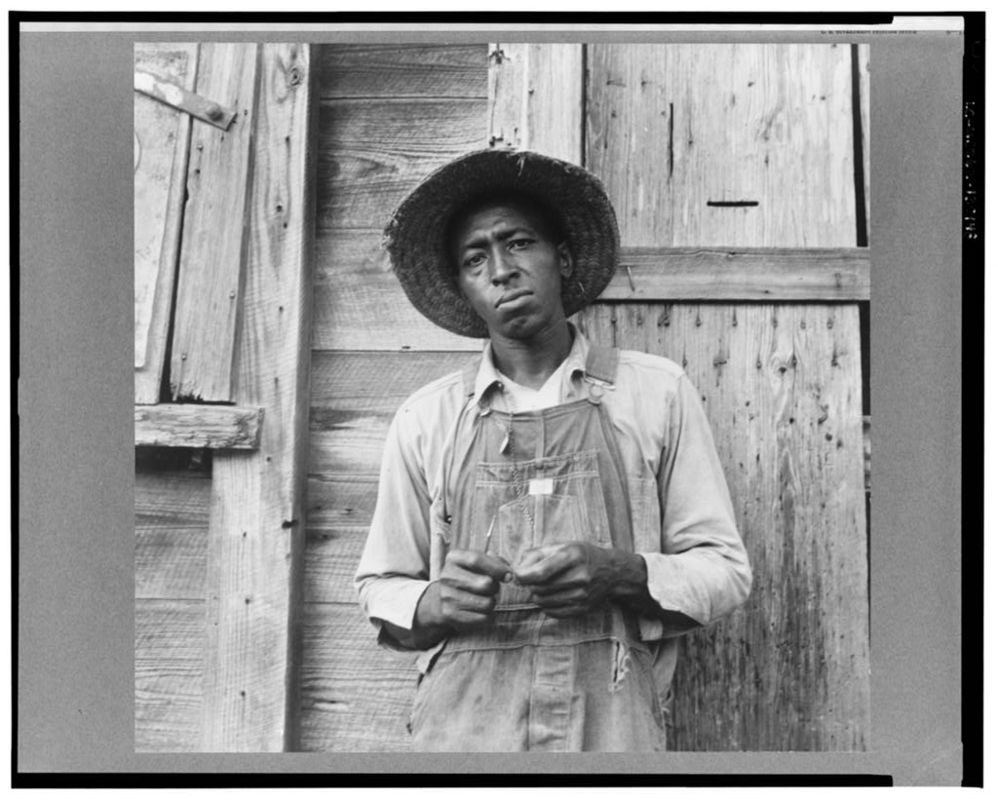
She had two explanations for this: first, she believed that everyone was attractive once they relaxed into their “natural body language;” second, because she saw a photograph as a collaboration between photographer and subject, the subject has every right to be represented as attractive. (In the latter argument she prefigured some recent critical theory about photography, notably in Ariella Azoulay’s The Civil Contract of Photography (MIT Press, 2008).
But it was more difficult for Lange to emphasize the upbeat when she began to photograph the round-up and the camps. Instead, she managed an artistic approach that characterized all her documentary photography: her images of suffering and unhappiness are nevertheless beautiful compositions, and these compositions attract the viewer and make it possible to really see, rather than to glance and look away. One such compositional theme, which was simultaneously a leitmotif of life in the camps, was the queue.
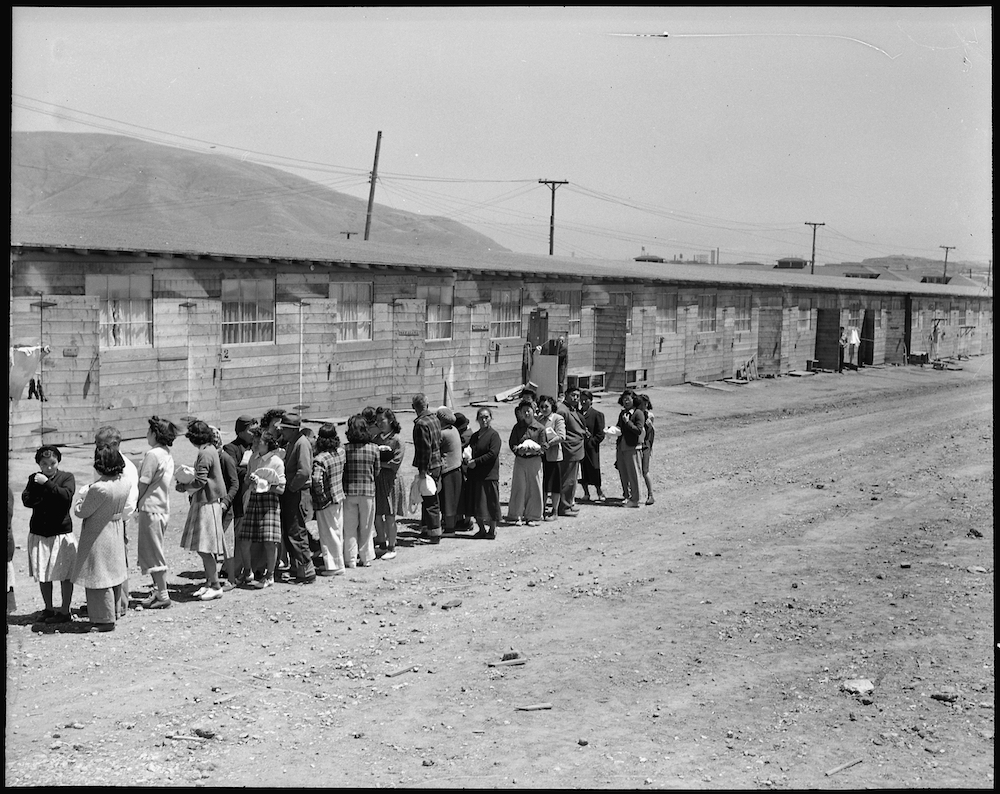
The internees had to spend hours waiting in line. They line up for their preliminary registration, they wait in chairs, they stand waiting before tables at which officials ask questions, fill out forms, receive instructions. Their scant belongings--they were only allowed to take what they could carry--also form queues on sidewalks and dirt roads. They wait for buses or trains to carry them away. They line up to be assigned to their quarters, to collect the straw that they had to use to create mattresses. They line up for toilets and laundry facilities, they wait in line for their meals.
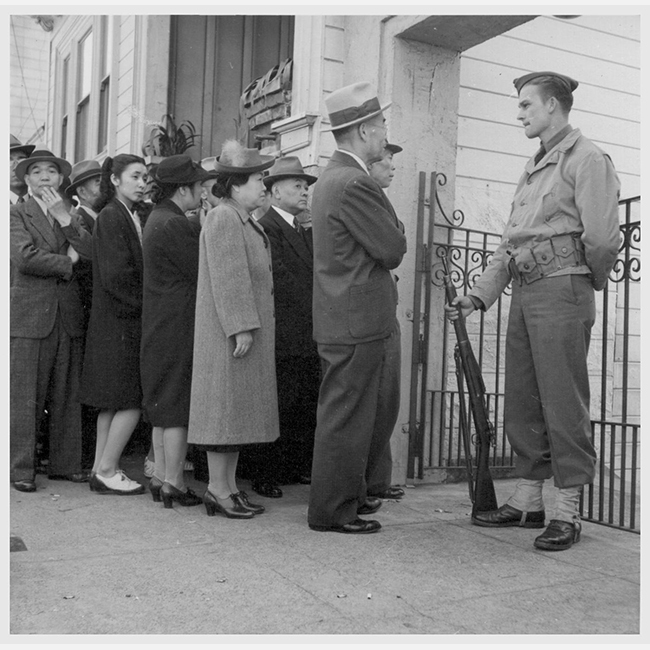
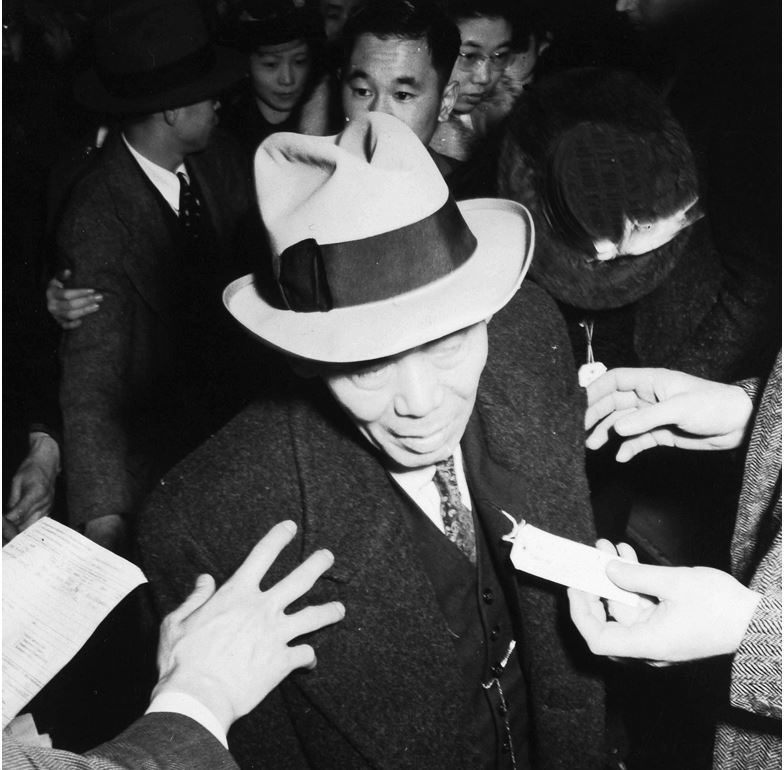
A second theme: tagging people, as if they were packages. The tags do not bear their names but a number: the head of each family received a number with a tag for each member of the family.
Father is 107351A, mother 107351B, children C through F from oldest to youngest, grandmother 107351G, and so on. Lange is taking us into a brave new world of rationalization and control, featuring the industrial and technological forms of domination described most influentially by Foucault. We see now that what is being stolen is not only farms and education and businesses and jobs but also personal identity. Individuals are registered, numbered, inoculated, tagged, categorized, and assigned. They are herded, segregated, exiled, inspected, billeted, surveilled.
Despite being infuriated, Lange mostly retained restraint and self-control, as did her subjects, and it is precisely this commitment to the discipline her craft requires that makes the photographs so compelling. She offered occasional humorous observations, albeit drenched in irony. In a private notebook she wrote, "As an old man lines up his baggage for the inspection, an alarm clock begins to ring [somewhere inside his bundles]. A young girl jumps off the bus in her brave new clothes all smiles, sees a friend up above, yells, `Hi, how is it?’ The other replies `awful’ and the smile fades ..."23 Occasionally the brutality of this ethnic cleansing, and the pain it caused, overwhelmed her. Lange’s friend and assistant Christina Page recalled how once " ...some Japanese farmer had driven his truck to town and a friend was going to take it back for him and his dog, a great big dog ... As the farmer got out of the truck and headed toward the train, the dog knew what was going on and the dog began to howl with a super-human, ungodly, just horrible screaming howl that was just the most heart-broken -- it was just an expression of the whole evacuation.... And can you imagine what it did to the owner of that dog?... And the M.P.s kept running around saying `Shut that dog up! shut that dog up!’ I mean nobody in that whole area could stand it. And finally the man that was supposed to drive the truck back to the farm couldn’t stand it any longer and he didn’t watch the train depart--he jumped in the truck and drove the dog off."24
Ansel Adams photographed at Manzanar a year after Lange did, producing work that, by contrast, reveals much about Lange’s perspective. He tried to walk a cramped line, opposing anti-Asian racism but avoiding opposition to the internment.25 Adams’ pictures, primarily portraits--surprisingly for a landscape photographer--emphasized the internees’ stoic, polite, even cheerful "making-the-best-of-it."26 His subjects were almost exclusively happy, smiling. His goal was to establish the internees as unthreatening, Americanized, open--scrutable rather than inscrutable.27
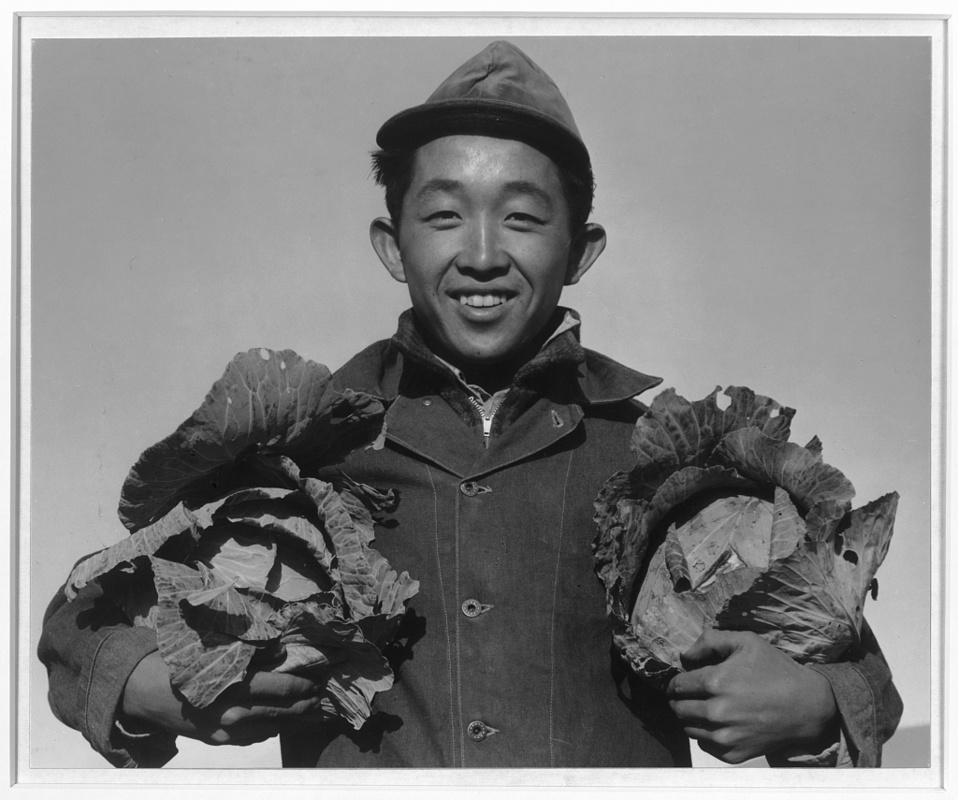
By making mainly individual portraits, he masked collective racial discrimination. The resultant hiding of the internment’s violation of human rights was not an unintended consequence of this goal, but an expression of Adams’ patriotism. He believed that "the acrid splendor of the desert, ringed with towering mountains, has strengthened the spirit of the people of Manzanar.... The huge vistas and the stern realities of sun and wind and space symbolize the immensity and opportunity of America ..."28 In November 1943 the Office of War Information asked him for permission to use his photos “`showing American kindness to Japanese ... urgently requested from our Pacific outposts to combat Japanese propaganda which claims our behavior is monstrous.’”29 "It was obvious to me that the project could not be one of heavy reportage with repeated description of the obviously oppressive situation. With admirable strength of spirit, the Nisei rose above dependency ... This was the mood and character I determined to apply to the project."30
Ansel Adams did not invent this observation; this positive attitude did characterize many of the internees and their fortitude deserves honor--although it was also an attitude condemned by more militant internees. Lange and Chris Page also noticed the patience31 of the internees, including even the children, and they also considered this a characteristic trait of the Japanese culture. Indeed, twenty years later she remained amazed at the lack of vengefulness on the part of some Japanese Americans she knew, such as Dave Tatsuno; "I don’t understand those people," she said.32
Some part of the differences between Lange’s and Adams’s photography came from the timing of their photographic work: by 1943, when Adams went, Manzanar was working better, and the internees had done far more to build their own culture. But more of the difference came from their political temperaments. Lange’s willingness to defy her employer, to resist the authoritative decision of a president she so much admired, was completely in character. Adams and Lange were friends, and because her photographs had been impounded she encouraged him to make his public; this was before she had seen them, I suspect. Twenty years later she was very hard on him, or at best patronizing:
That’s Ansel. He doesn’t have much sense about these things. He was one of those at the beginning of the war who said--they’d had Japanese in their home always as house help and that was characteristic of his household--he said he saw the point. `You never get to know them,’ and all this. He gave the regular line, you know, but he wasn’t vicious about it. He’s ignorant on these matters. He isn’t acutely aware of social change. It was far for him to go, far. He felt pretty proud of himself for being such a liberal ... on that book.... He doesn’t know how far short it is, not yet.33
Yet Lange offered no images of resistance. This may have been overdetermined, because the army would not let her near any evidence of it, and because she did her work so early in the development of the camps. The closest she came to signs of resistance was in private conversations with people she knew well enough that they trusted her to keep their comments off the record.34
Sequestering these photographs deprived not only their author but also Americans as a whole. To evaluate this loss, we need to consider the formative role of the visual in constructing the common understanding of the internment--and of all racisms and patriotic hysterias. Photography heavily influenced public opinion on these matters, and the Depression and World War II period represented a major leap upwards in that influence. In fact, the construction of Japanese and Japanese Americans as an internal enemy was itself partly a visual process. A cartoon of the Japanese face was imprinted on the public through posters, graffiti, atrocity films, cartoons and caricatures. The epicanthic eye fold and prominent teeth in particular became visual tropes for a despised, allegedly untrustworthy, and now enemy "race."It must have been bitter for Lange to see these months of intense and passionate work confiscated, seemingly erased. The work was physically and emotionally draining.
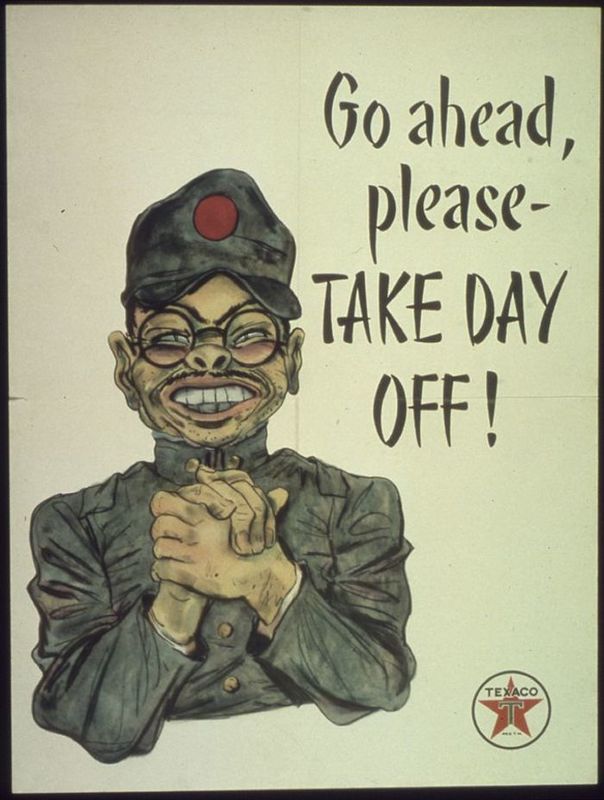
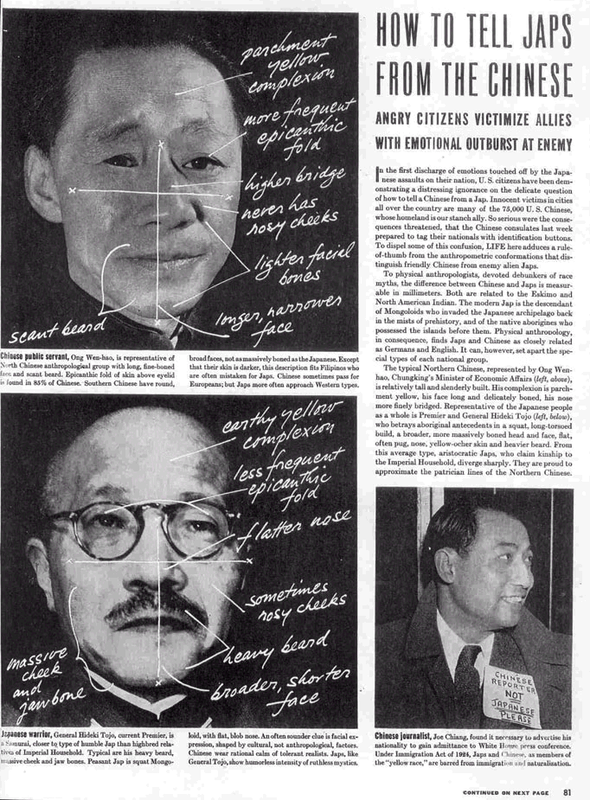
The War Department (as the Department of Defense was then called) even sought to teach whites how to distinguish people of Japanese descent from those of Chinese descent, as this image from Life Magazine shows.
The racist images were particularly authoritative to a public only just beginning to be saturated with photographic images. Given the long background of anti-Japanese racism on the west coast, photography both intensified and reshaped racial categories, molding "Japanese" as a "visual field" signifying disloyalty and treachery.35 American patriotism became racialized—as white. Lange’s emphasis by contrast was on how “American” were the Japanese-Americans—as in this witty and ironic photo of hip teenagers imprisoned at Manzanar.
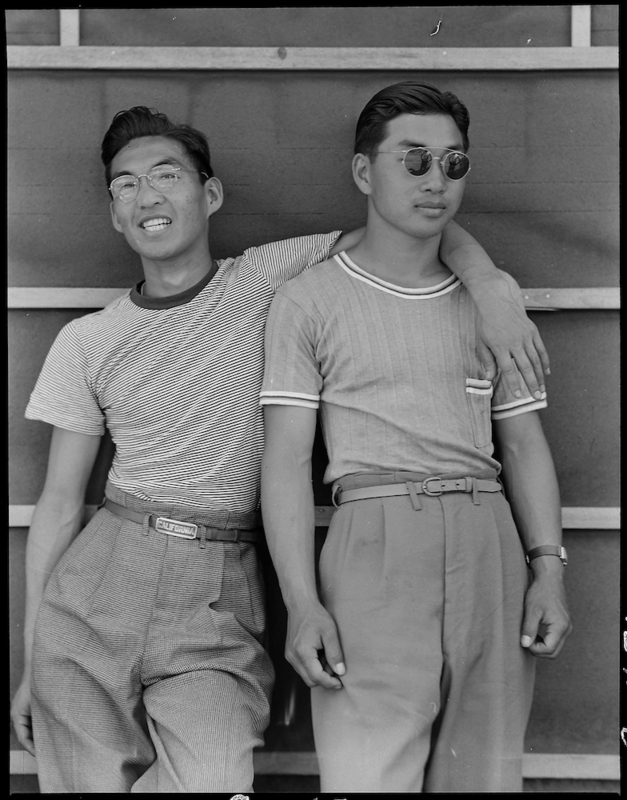
I have often wondered whether Lange’s images—directly countering that anti-Japanese racism—would have made an impact had they been distributed at the time.
This essay is an abridged and revised version of my introduction to Impounded: Dorothea Lange and the Censored Images of Japanese American Internment (NY: W. W. Norton, 2006), which contains 117 of these photographs.
Related articles
Linda Gordon, Internment Without Charges: Dorothea Lange and the Censored Images of Japanese –Americans
Teresa Goudie, Blood-Sacrifice in the Politics of a Nation-State: Japanese-Americans in Hawaii During and After World War II
A. Wallace Tashima, From the Internment of Japanese Americans to Guantanamo: Justice in a Time of Trial
Mark Selden, Remembering ‘The Good War’: The Internment of Japanese-Americans and the Atomic Bombing in U.S. History Textbooks
Gary Okihiro, Japanese Americans and the Making of US Democracy During World War II
Notes
Richard Conrat, one of Lange’s assistants and protegés, together with his wife Maisie Conrat, produced Executive Order 9066,which included 27 of her photographs, published as a report of the UCLA Asian American Studies Center in 1972.
I have been unable to determine the legal basis and form of this suppression--that is, who made the decision, how it was decided and communicated, and under what authority. But my hunch is that in this wartime situation, army officials felt authorized to make many censorship decisions unilaterally. As late as 2006, when Impounded appeared, the government was still reluctant to use Lange’s photographs, well after the internment’s wrong had been recognized and apologized for. For example, the National Park Service’s website on Manzanar then included 91 photographs, of which 8 are Lange’s: none were among her most significant and only one was at all critical.
McWilliams oral history, on line at Sunsite, UC Berkeley, “Japanese-American Relocation.” Incidentally, the African American response was more divided. Crisis, magazine of the NAACP, published a scathing denunciation of the internment: Harry Paxton Howard, “Americans in Concentration Camps,” Sept. 1942, vol. 49n #9, pp. 281-302.
Historian David Gutiérrez is typical of today’s scholars of Mexican Americans in his judgment that Taylor’s were "the most sensitive and penetrating studies of evolving Mexican American-Mexican immigrant relationships ..." David Gutiérrez, Walls and Mirrors (Berkeley: University of California Press, 1995), p. 64.
Personal Justice Denied: Report of the Commission on Wartime Relocation and Internment of Civilians (Washington, DC, 1982), p. 6.
Suzanne Riess, interviewer, “Dorothea Lange: The Making of a Documentary Photographer,” transcript, University of California Regional Oral History Office, Berkeley, 1968, p. 189.
Karen Will, interview with Tom Bodine, who worked at the time for the American Friends Service Committee, here.
Caleb Foote to Al Hassler of Fellowship of Reconciliation 8/8/42, JDC papers; Hearings before the Select Committee Investigating National Defense Migration, US House of Representatives, 77th Congress 2nd Session, pursuant to H.Res. 113, part 29, p. 11804K; HM interview with Caleb Foote, 9/3/98.
It is important to keep in mind that in the 1940s there was no widespread awareness of how photographs could be doctored; but there was plenty of awareness of selectivity and point of view in photography.
In this respect Ansel Adams’ later photographs at Manzanar were similar, although in other respects quite different.
Personal typed notes, April 1942, Paul Taylor papers, Bancroft Library, University of California Berkeley.
Richard Keith Doud interview with Christina Gardner, Archives of American Art, Smithsonian Institution, transcript, p. 26.
Ansel Adams papers, Box 1, UCLA, passim; Adams to Nancy Newhall, 1943 nd, in Mary Street Alinder and Andrea Gray Stillman, eds., Ansel Adams: Letters and Images 1916-1984 (Boston: Little Brown, 1988), pp. 146-8.
Elena Creef points out Adams’ disproportionate photography of young girls, as if he instinctively wanted to picture the least threatening internees. Elena Tajima Creef, Imaging Japanese America: The Visual Construction of Citizenship, Nation, and the Body (NY: NYU Press, 2004), pp. 21-2.
Ansel Adams, Born Free and Equal (2nd ed., Bishop, CA: Spotted Dog Press, 2001), p. 13. In his autobiography, which is more critical of the internment, Adams defensively apologizes for this statement; Ansel Adams, Ansel Adams: An Autobiography (Boston: Little Brown, 1988), p. 260.
Estelle Campbell to Ansel Adams 11/22/44, quoted p. 209 from an unpublished paper by Nicholas Natanson, in Center for Creative Photography, Tucson, Arizona.
Ansel Adams, Ansel Adams: An Autobiography (Boston: Little Brown, 1988), p. 260, quoted in Karin Higa and Tim B. Wride, "Manzanar Inside and Out: Photo Documentation of the Japanese Wartime Incarceration," in Reading California: Art, Image, and Identity, 1900-2000, eds. Stephanie Barron et al (Los Angeles: University of California Press, 2000), p. 324. Adams wrote to Imogen Cunningham, “... my main interest is to put over the idea to the sentimental man in the street (if there are any) and stay clear of the professional `socially aware’ crowd.” Adams to Imogen Cunningham, nd, in Imogen Cunningham papers, Archives of American Art, Smithsonian Institution.
John C. Welchman, "Turning Japanese (in)," Artforum International vol. 27, 4/89, 152-6; Emily Medvec, introduction to Born Free and Equal: An Exhibition of Ansel Adams Photographs (Washington, DC: Echolight, 1984).
[Linda Gordon is a University Professor of the humanities and Professor of History at New York University. She is the author of the Bancroft Prize-winning The Great Arizona Orphan Abduction and other books dealing with the history of controversial social policies, such as birth control and protection against family violence. Gordon and Gary Y. Okihiro are the editors of Impounded: Dorothea Lange and the Censored Images of Japanese American Internment.]
Moderator Note: Please refer to original article for additional photographs. This article is posted in honor of The Day of Remembrance (DOR) which is a day commemorating the Japanese American internment during World War II. Events in numerous U.S. states are held on or near February 19, the day in 1942 that Executive Order 9066 was signed, requiring internment of all Americans of Japanese ancestry.

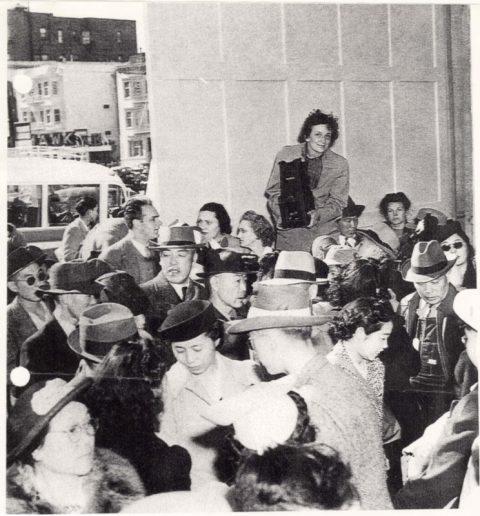
Spread the word